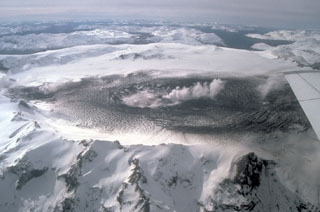Report on Cerro Hudson (Chile) — March 1992
Bulletin of the Global Volcanism Network, vol. 17, no. 3 (March 1992)
Managing Editor: Lindsay McClelland.
Cerro Hudson (Chile) Sulfur odors; increased river flow and turbidity; fine August 1991 ash remobilized
Please cite this report as:
Global Volcanism Program, 1992. Report on Cerro Hudson (Chile) (McClelland, L., ed.). Bulletin of the Global Volcanism Network, 17:3. Smithsonian Institution. https://doi.org/10.5479/si.GVP.BGVN199203-358057
Cerro Hudson
Chile
45.9°S, 72.97°W; summit elev. 1905 m
All times are local (unless otherwise noted)
Sulfurous odors were occasionally detected up to 90 km S and SE of the volcano, beginning 10 April and increasing to a peak at 1100 on 13 April. Residents of Murta (60 km SSE) and Puerto Tranquilo (80 km SSE) reported headaches and nausea at 1500. The Civil Aviation Administration confirmed the intense sulfur odor SE of the volcano, but direct observation of the summit on 13 April revealed no visible eruptive activity. At 1700 on 14 April, an abnormal increase in river flow volume and turbidity was reported from Puerto Ibáñez, 90 km SE. Geologists suggested that the observed phenomena were a result of increased thermal and fumarolic activity beneath the caldera glacier (10 km diameter), combined with the abnormally dry weather conditions.
In late March, aeolian re-suspension of ash from Hudson's August 1991 eruption continued in Argentinian Patagonia. The following is from a report by the Patagonian Volcanism Project.
At about 1030 on 30 March, the crew of flight TAN 404 (Malargue to Neuquen), noted a brown "dust veil" ~50 km S of Malargue, at ~ 6,000 m altitude. Finely dispersed, light-brown volcanic ash formed a well-defined layer ~100 m thick and 300 km wide that spanned the horizon. The layer was rather homogeneous and perfectly visible against the cloud-free blue sky, but once within it the layer was no longer evident. The pilot reported that the layer had not originated from nearby surface dust, but was the result of Hudson ash again being transported to high altitudes from Argentinian Patagonia following calm weather that had prevailed in late March.
The ash was not from a recent eruption, but was entirely due to reworking of volcanic ash in dry, windy Santa Cruz Province, Argentina. On 21 March, re-suspended ash was deposited in Comodoro Rivadavia, accompanying local precipitation and a drop in temperature. At that time, strong southerly winds in Southern Patagonia suspended the ash, which preferentially traveled N along Argentina's Atlantic coastline and the Andean foothills. Other atmospheric effects included lowering of the dust layer during cold morning conditions, followed by ascent during the day due to surface heating, and fiery-red to pink high-level clouds seen in Comodoro Rivadavia at dawn on 31 March.
Volcanic bombs from the Hudson area contain black streaks in highly vesicular lighter-colored pumice. However, microprobe data indicate that the clear and dark glasses have essentially identical high-K dacite compositions.
Geological Summary. The ice-filled, 10-km-wide caldera of Cerro Hudson volcano was not recognized until its first 20th-century eruption in 1971. It is the southernmost volcano in the Chilean Andes, related to subduction of the Nazca plate beneath the South American plate. The massive volcano covers an area of 300 km2. The compound caldera is drained through a breach on its NW rim, which has been the source of mudflows down the Río de Los Huemeles. Two cinder cones occur N of the volcano and others occupy the SW and SE flanks. This volcano has been the source of several major Holocene explosive eruptions. An eruption about 6,700 years ago was one of the largest known in the southern Andes during the Holocene; another eruption about 3,600 years ago also produced more than 10 km3 of tephra. An eruption in 1991 formed a new 800-m-wide crater in the SW portion of the caldera.
Information Contacts: J. Naranjo, SERNAGEOMIN; P. Bitschene, A. Arizmendi, M. Fernández, N. Arias, and A. Nillni, Patagonian Volcanism Proyect, Argentina.

